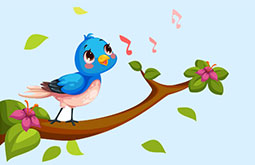Children's Book Illustration - Tips for Creating Charming Characters
It appears to be very easy to design and mediate the content available in a book which is designed for youngsters. When you attempt to create a single story, then only will you notice the required amount of effort and expertise. They are designed for young ones who demand creative story telling techniques and captivating artworks. It is quite challenging for newbie designers who are into the field of demonstrating cartoons and portraits. If few tips are considered while designing illustration for children's book, the efforts will not be in vain.

Clearly understanding the concept

Visualization is next to printing the idea. It is a challenge to draw something on a blank page. If you find it quite baffling, then re-read the article which you have considered as the story telling phase. Then pictures can be drawn. This helps to create some space and a necessary frame in which the designer can expand his work. Children’s books illustration requires the ability to convey what the story tells.
Colors, fonts and elements

Creativity to an extent helps to convert a dull story into a bright one. Another important one among the top children's book illustration style tips that helps to boost marketing is the usage of brightly colored elements. Colorful fonts, design constraints, layout and usage of some bright colors often help the story to be vibrant. They establish mood, tone, voice and content for particular environment. Surprising artistic blocks can be viewed if they are used sparingly. If a children’s book has successfully adopted measures to bring enough color and content, then it will surely be a hit. Sparkles and design elements when used along with a unique layout also brings some vivid perspectives into picture.
Character design

Designing eBooks for children is not always easy. In fact the content needs to be simple but immersive. They have to keep little readers stick to the story. It requires perfect layout and an array of unique characters. Characters must have certain properties which distinguish them from the regular ones like shape, size, and parameters like tall, lean, black, grey or hairy. A spectacular portfolio of staples will ensure that you have a lot of creative layouts to begin. Before drawing a character, it is mandatory to understand how it looks and behaves. A silly character who is lazy can be very different from one that is strict and serious. Such effects have to be considered in mind before designing.
A thought about the readers

It seems to be very challenging at the beginning. One has to take into account various elements like the story’s backdrop, location, concept, tone, moods, character’s expression, their attitude, characteristics and many such things. For starters, it is advisable to begin with the settings of the characters as well as the supporting characters before finalizing any digital illustration styles.
Most essentially, you have to give a thought about the readers as well. Creatively you have to find a middle path to do justice to the period in which the story is set and at the same time, match those elements to the current, modern scenario with which today’s kids can relate to. But that doesn’t mean you would show a medieval-age character carrying a mobile phone. You have to infuse sense in what you are creating. Similarly it is important not to go overboard while reflecting any kind of expression, say fear. Since the book is meant for a young audience, the characters’ features shouldn’t harm their minds but make them understand by coming up with appropriate types of illustrations.
Get it reviewed
For the sake of improvisation, one needs to have their works assessed by the writer of the book himself. After the first draft is set, the publisher along with the writer can discuss over it; as to what has to be modified or what can be added. Following their suggestions, you can get on to work further on the changes – whether to make more room for the content, or adding more elements or shifting objects to certain places – you should be able to modify according to the feedback received.
Maintain a consistent flow

Once the review is done, one can sit down to have the layouts reworked. In this stage, you can check if the children's book character design needs any modifications and most importantly, whether the flow of the story is intact. It is bit tricky to retain consistency in the image proportions or features of the characters and to ensure that they look same, no matter from what angle you see. While you may have certain illustration blend with the text in one portion, it may not turn out to be the same on another page. Thus, one has to remain on toes to welcome any kind of changes and include them in the layout.
The final stage

Once you are completely satisfied with the modifications and happy with the outcome, it is the time to send the artwork to the client. Although there will be hardly any changes at this stage, one can expect some comments as an author or publisher would be very much aware about the importance of illustration in children book. Get the final traces on to the layout paper and mark an outline to indicate where the book has to be cut while printing and make another outline for ‘bleed’ (an extra space to allow mistakes during cutting process). Once done, go ahead to make full length copies with the final traces and send it across to the client for further review.
Conclusion
If you find it really hard to follow these practices or if there is requirement of a more professional designer who can carve the photographs according to the story, then expert companies which provide book illustration services would be a nice option. However these illustration firms are available in plenty and hence require thorough research to be done before getting into a contract with one. Be careful while selecting your service provider so that your investment goes for the right cause.




